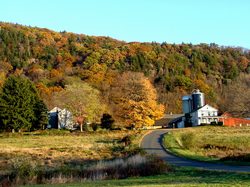You are here
Factors Influencing Autumn Leaf Color
 Although always impressive, autumn leaf colors vary from year to year, and seem to be more intense in some regions. For instance, aging leaves in tropical forests generally do not change color. People in New England would argue that the autumn colors in their forests are the most colorful, although people in the southern Appalachians would argue otherwise. Predicting color intensity and timing may be economically interesting because the colors are a huge tourist draw, worth hundreds of millions of dollars in revenues every year. The following factors appear to be important in the color displays.
Although always impressive, autumn leaf colors vary from year to year, and seem to be more intense in some regions. For instance, aging leaves in tropical forests generally do not change color. People in New England would argue that the autumn colors in their forests are the most colorful, although people in the southern Appalachians would argue otherwise. Predicting color intensity and timing may be economically interesting because the colors are a huge tourist draw, worth hundreds of millions of dollars in revenues every year. The following factors appear to be important in the color displays.
What Trees are Present
Few broadleaf trees, and lots of conifers, mean a primarily green display in autumn. In the northeast more pines and hemlocks reduce the color intensity, although the presence of some conifers provides a nice contrast to the bright colors. European forests seem to lack many species that produce good color, especially the reds. Some trees produce their colors earlier than others, and the mix of species may affect the peak color production.
Summer Weather
Summer drought conditions stress trees. They may thus lose their leaves prematurely or start color production prematurely. The result is a reduction of color during the peak of the season. Adequate summer rains promote good tree health, leaf retention and, therefore, color production during the autumn.
Autumn Weather
The right weather during the autumn can promote more intense color production. The reds (anthocyanins), which require sunlight for production, are enhanced by cold and sunny days. Rainy and windy weather during the autumn can knock leaves down prematurely thereby shortening the color display at its peak.
The timing of many individual species' autumn coloration and leaf drop is being documented at the Harvard Forest. These changes along with the timing of a plant's flowering and leaf development in the spring are part of what is called its phenology, a term that includes all relationships between periodic biological activity and climate, including migrations, dormancy, etc. In addition to on-the-ground measurements of tree phenology, we also measure seasonal changes at the Harvard Forest using webcams perched atop our research towers.

